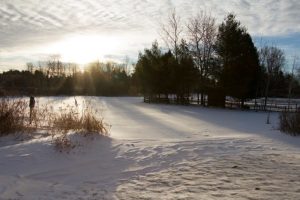
I don’t know about you, but this year’s autumn, as wonderful as the season was, seemed to pass as swiftly as the migrating nighthawks and then just vanished. I am left with nothing more than a memory of a warm, golden sunshine and evenings by the river, trees dripping with warblers, and the ground full of sparrow sounds as they anticipate another night’s flight. Reality sets in and is followed by a sudden transition from a tan to white landscape.
We all need a break, I think, and winter is a gift if we take advantage of it. Like the wildlife around us, I think we tend to gear up in the fall, but we don’t always take time to recover in the cold. Of course, taking a break doesn’t mean one’s imagination will go dormant.
The first walks across the land in winter are so revealing. Tracks reveal mammalian neighbors that we’ve forgotten during warm times- fox tracks cross the yard, but I haven’t actually seen a fox in months. The crimson and gray remains of what was once a cottontail are starkly evident in the snow, coyote tracks all around. A muddy patch reminds me that there is a spring on the hillside- a great place for a trail camera to be placed. Pine siskins scold each other harshly as they fly over. The river hasn’t completely frozen in the shallows yet, and a few ducks pass by to take a look. Perhaps a great blue heron lingers? No, not today.
A couple of chickadees follow along for a while. Despite their cute appearance they are probably wondering if I’ll scare up a meal for them – or do the dirty work and leave them a carcass. Or maybe its my carcass they’re wondering about? Mine could feed a whole flock of chickadees for the winter. I decide that perhaps their intentions aren’t quite so gruesome, and concentrate on other wonderings.
As I cross a small field that a month ago launched hundreds of tufted milkweed seeds into the air I think about all the things beneath the snow- meadow voles that are tunneling just above the soil, springtails and spiders picking their way among the crystals, and the thousands of wildflower seeds sown late in the year, now sleeping beneath a safe, icy blanket. With each freeze and thaw they settle into the topsoil a little more completely. I hope their pollen feeds lots of little bees and their seeds will be feeding the goldfinches in a few years.
As I walk I think more and more about how the birds need the bugs, and how the bugs need the native plants, and how alarming it is that there seems to be more and more evidence that it’s getting to be harder for bugs to survive. We’ve long talked about how cockroaches will supposedly outlive human beings, mistakenly missing the importance of the survival of the roach’s cousins. We’ve failed, with the exception of a few exceptional folks, to fully appreciate what we’re still doing to the bees, beetles, and flies of the world in removing their native food and poisoning them beyond the borders of our crops. Perhaps the bugs need to be my livestock of choice, and the crops I plant should be those that sustain them in all their diversity.
All of these things: the plants, bugs, and birds are gifts of nature. We can’t possess these gifts, they all have lives of their own. The best thing we can do is to cherish what is given and to nurture, so that these gifts can be enjoyed forever by others.
My walk is done and I’m back in the warmth. I pull up the native nursery websites. Lets see, how many oaks should I plant for the warblers this coming year?
photo taken at Woodland Dunes by Nancy Nabak
